Japan is renowned for its world-class rail and outstanding cuisine, and one of the best ways for travelers to experience both is by sampling ekiben (bento boxes designed for train travel).
Ekiben, ubiquitous in train stations throughout Japan, are much more than basic pre-arranged meals in a box. Reflecting local and seasonal specialties, the best ekiben are beautifully presented and feature a colorful array of ingredients, offering travelers a uniquely Japanese culinary experience.
Excited to explore Japanese cuisine while traveling between Japan’s best destinations? To help you travel like a local, we’ve put together this guide to Japan’s beloved train food so you can dine in style while riding the rails.
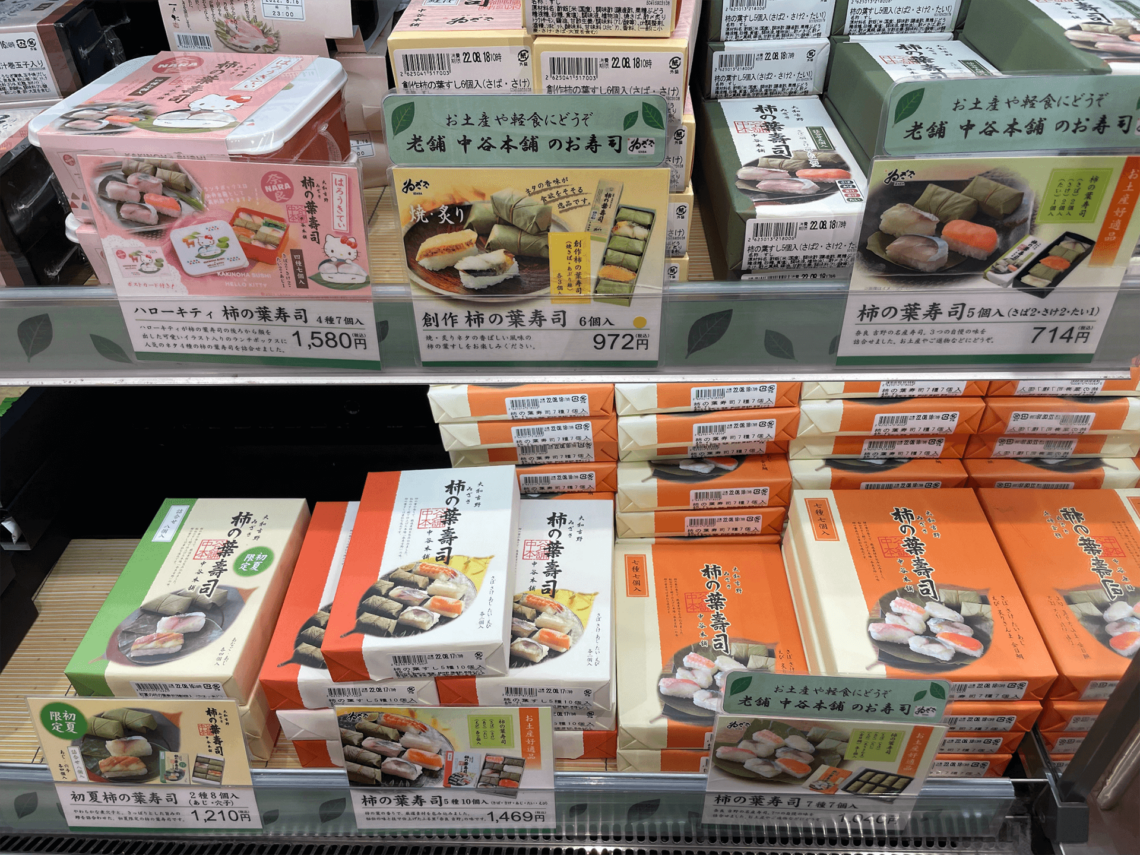
What Are Ekiben?
The word ‘ekiben’ is a portmanteau, combining the Japanese ‘eki’ (meaning ‘train station’) and a shortened form of ‘bento’ (meaning ‘lunch box’). These boxed bentos are sold at long-distance train stations across the country, often using regional ingredients that capture the taste of Japan’s individual prefectures.
A far cry from pre-packaged, nutritionally poor snacks, ekiben are well known for high-quality ingredients. To create a balanced meal, these bentos usually contain rice or noodles, vegetables, and meat, fish, or seafood for protein.
The dishes can range from the simple (omelets, rice balls, tempura, or fried tofu) to the more extravagant (sea urchin, grilled beef tongue, stewed eel, and rice pilaf, or tender Wagyu beef). The katsu sando (breaded pork cutlet sandwiched in white bread) is a classic lunchtime favorite, and you’ll often see gyoza and sushi in ekiben form too. As long as it’s portable and designed for train dining, virtually any meal can be enjoyed as ekiben.
The decorative outer packaging of ekiben is occasionally elegant or unique enough to warrant keeping as a souvenir. Whether lacquered wood, a ceramic pot, or a plastic storage box shaped like its bullet train namesake, these ekiben containers can be reused once empty – perhaps even for making bento at home.
While it’s not common etiquette to eat and drink on local transit in Japan, long-distance trains such as the shinkansen (bullet train) are a different matter. Not only is it perfectly acceptable to enjoy a meal on board, it’s a national tradition, and shinkansen seats have tray tables for this specific purpose. There’s something wonderfully charming about savoring your ekiben while watching the scenery fly past through the window.
Read more about getting around in our comprehensive guide to train travel in Japan, and why the JR Pass isn’t the best option for many travelers.
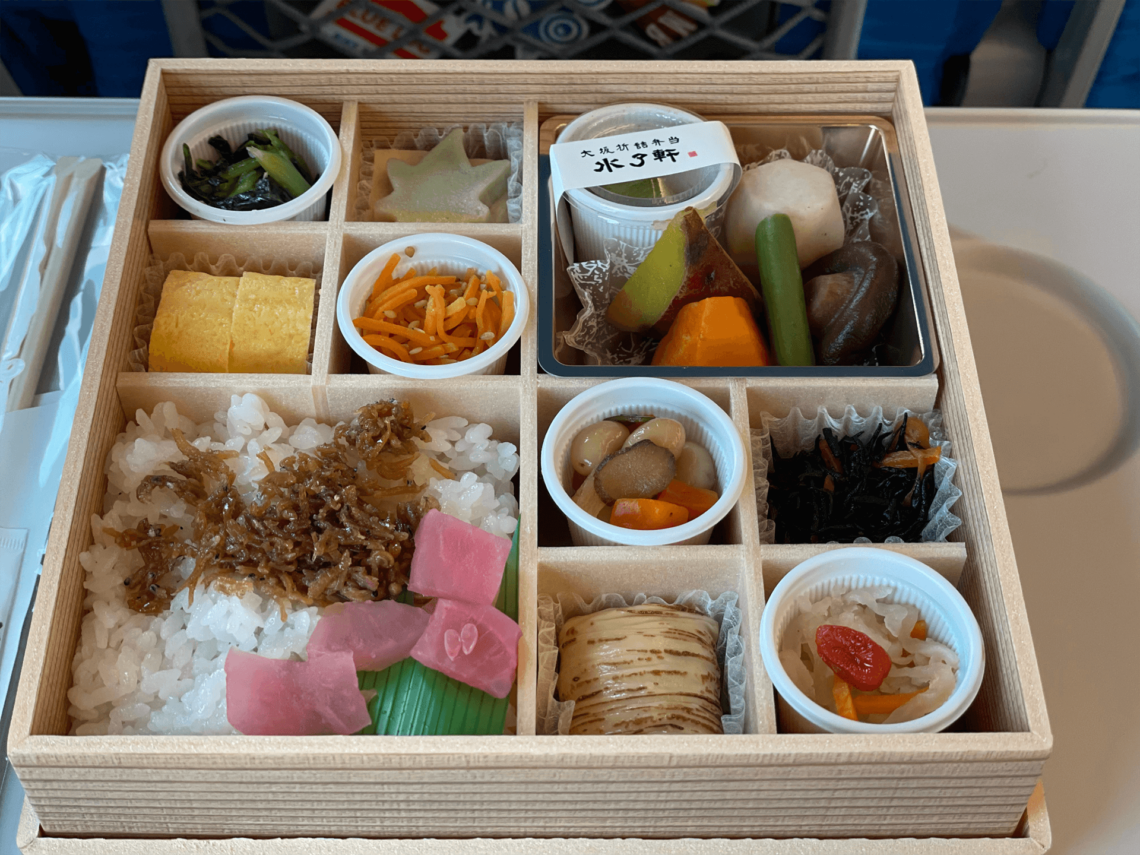
How Did Ekiben Become Standard Fare for Travelers?
Especially compared to train food in other countries, ekiben are outstandingly beautiful and delicious. But they remain a food of the people, and their popularity has grown alongside the development of the unparalleled Japanese rail network.
The first ekiben can be traced back to Tochigi prefecture in the late 19th century when a new JR line was established. At Utsunomiya Station in Japan’s northern Kanto region, vendors walked the platforms and sold a ‘station lunch box’ to passengers through the train window: a meal consisting of two freshly made onigiri (rice balls) and a few slices of pickled daikon (radish), all wrapped in a sheet of bamboo leaves. (Fun fact for food-lovers: Utsunomiya is now synonymous with gyoza!)
While not the elaborate ekiben we know today, these early train lunches were happily welcomed thanks to the pre-existing popularity of bento, a compactly carried and neatly compartmentalized boxed meal. Japanese families had been carrying bento to work or school for centuries, so train-specific bento was an easy transition. However, the earliest ekiben were not yet an affordable option for the majority of train passengers.
A few years later, a combination meal of white rice and side dishes like rolled omelets and fish cakes was sold by vendors at Himeji Station in Hyogo prefecture. In the late Showa Period, ekiben began to appear at successive stations, sold on the platform’s edge by stall holders taking advantage of the steam train’s frequent pauses along its route.
By the 1950s, personal train travel was booming: more people needed to eat during their long journeys, and the use of more local ingredients made ekiben a cheaper and thus more accessible option for travelers.
By the 1980s, ekiben had evolved to a point of cultural necessity. Particular regional ekiben were only available at one specific train station, creating a layer of uniqueness to a traveler’s journey – though department stores also began hosting annual ekiben tournaments for people to try Japan’s regional varieties without the need to travel.
Though today’s modern trains are much faster and there are more dining options available, ekiben are firmly entrenched in Japan’s culinary culture.
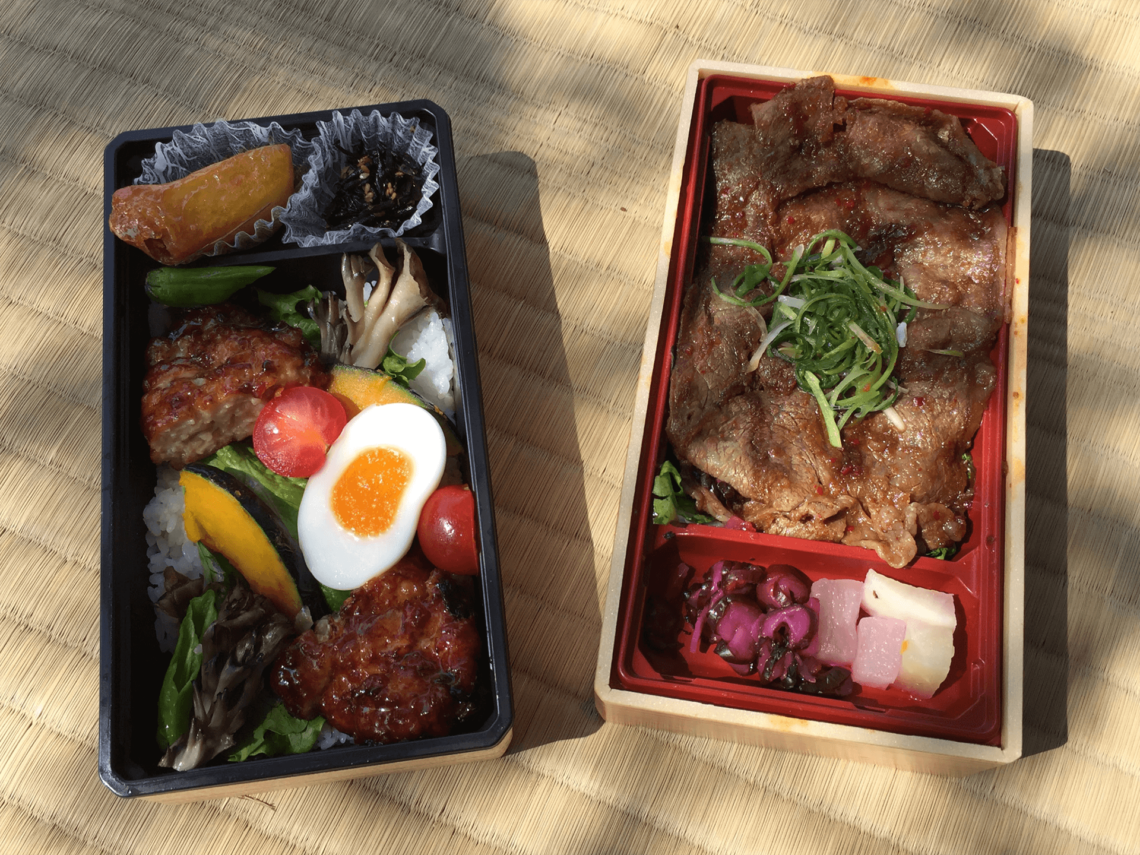
Where to Find the Best Ekiben
Ekiben are usually best purchased before your train journey: Though some trains will offer on-board food service (trolley service), it’s not a guarantee. For instance, the Kagayaki Shinkansen (Hokuriku Shinkansen), which connects Tokyo with Kanazawa, has the luxurious ‘Gran Class’ service. This ticket class comes with unlimited drinks and a small bento – though we still suggest shopping for bentos at Tokyo Station beforehand, as it’s a unique experience to browse the shops ahead of the journey.
Scouring the shelves for a bento box that takes your fancy is a wonderful part of preparing for the shinkansen, and there are plenty of places to choose from. In Tokyo Station, you’ll find perhaps the biggest array of ekiben in the country: There are beautiful selections of bentos throughout the station, along with specialty snacks and sweets, and Japanese craft beers and sake to enjoy on the train.
Keep in mind that time of day makes a difference: browsing during the commuter rush-hour means you’ll definitely be queuing for your ekiben!
Here are a few of our favorite places in and around Tokyo Station to browse for unique and high-end ekiben:
- Daimaru Tokyo department store has a wonderful depachika (food hall) that opens at 10:00 am. You’ll find it connected to the station’s Yaesu North Exit.
- eCute and GranSta, two shopping areas within the main ticket gates, are great places to pick up a variety of premium bentos, sweet treats, and more.
- Ekiben-ya Matsuri is an extremely popular store, just past the ticket gates on the first floor of Tokyo Station. With over 170 different types of ekiben, including many regional varieties from around the country, it’s a perfect place to browse.
- For some quality sake to complement your meal, visit Hasegawa Saketen in the GranSta shopping area, which also has plenty of wine and craft beer.
Shopping for ekiben in-store also allows you to ask more questions before you buy. Bigger stores will have allergen information and English translations available, though there are often plastic representations or photos of the bentos on sale.
If you have food allergies or restrictions, read our guide to traveling in Japan with dietary requirements.
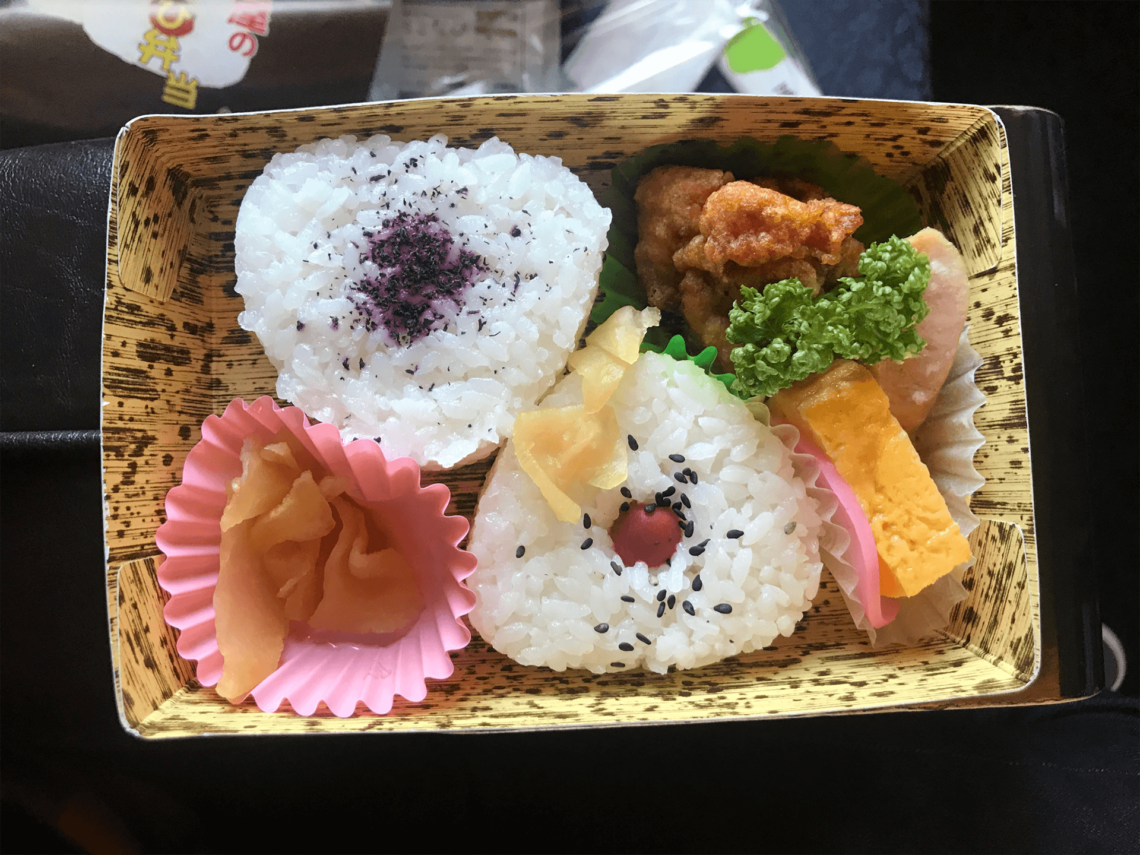
Best of the Ekiben Bento Menu
With thousands of variations of ekiben available in Japan, it can be a little overwhelming to make a choice. Our preferred method is to keep an eye out for the most intriguing or beautifully packaged bentos while you browse the shelves. Culinary adventurers can opt for the specialties that each region is known for, like Hokkaido’s seafood, Mie’s Wagyu beef, or Sendai’s grilled beef tongue.
Here are a few of the best varieties to try when traveling around Japan:
Shinkansen E7 kei Bento
A perfect souvenir item courtesy of Ekiben-ya Matsuri in Tokyo Station, this shinkansen bento box comes in the form of a brightly painted plastic bullet train. Inside is a range of classic foods – fried chicken, onigiri, shrimp tempura and pickled vegetables – making this ekiben particularly appealing to the young travelers in your group.
Masu no Sushi Toyama
The most well-known regional dish of Toyama prefecture is Masu no Sushi: strips of local fatty trout that’s been salted and seasoned atop a round bed of dense, sticky rice. The ekiben version is also presented in a circular fashion, wrapped tightly in bamboo leaves to maintain pressure and held in a round cedar wood box which allows adequate aeration for the sushi. It’s so unique that there’s even a museum in Toyama City dedicated to the 300-year history of creating this regional specialty.
Daruma Bento Gunma
Another popular collectible ekiben box is the daruma bento, shaped like the traditional doll from Takasaki in Gunma prefecture which is a talisman for good luck. After enjoying a meal of rice, chicken, and vegetables hiding beneath the daruma’s face, you can use the emptied daruma-shaped box as a coin bank via the doll’s open mouth.
Hipparidako Meshi Nishi Akashi
Akashi in Hyogo Prefecture is renowned for both its plentiful and tender octopus and the clay Takotsubo pots traditionally used to catch them. The result is an ekiben served in a reusable ceramic pot that’s opened to reveal fluffy rice on a soy sauce base, shiitake mushrooms, bamboo shoots, carved carrots, and the show-stopper: chunks of local stewed octopus. First sold at Nishi-Akashi Station along the Sanyo Shinkansen line, the Hipparidako ekiben is now a popular dish sold at multiple JR stations in Hyogo.
Moo Taro Bento Mie
It’s difficult to miss the striking container of this Moo Taro Bento, shaped like a cow’s head complete with horns and a nose ring. Inside, you’ll find premium Wagyu beef and chopped ginger strips served on a bed of rice, with a small serving of pickles alongside – and you’ll also be treated to a musical rendition of the ‘Furusato’ folk song, which plays whenever the lid is removed.
Kaizen Ezo Shomi Sapporo
The quality and freshness of the seafood from Hokkaido is outstanding, thanks to the cold waters surrounding the prefecture. Dining on the Kaizen Ezo Shomi ekiben is a luxurious yet surprisingly cost-effective way to sample the best of Hokkaido’s seafood: locally caught salmon, crab, scallops, sea urchin and fish roe, all served on a bed of vinegared sushi rice.
Ika Meshi
Hailing from the Oshima area of Hokkaido, Ika Meshi contains two small simmered squids seasoned with soy sauce and stuffed with sweet sticky rice. This ekiben is usually sliced into rings for easy eating, although sometimes the squid is simply skewered on a stick. It’s most readily available at Mori Station and other stations in Hokkaido.
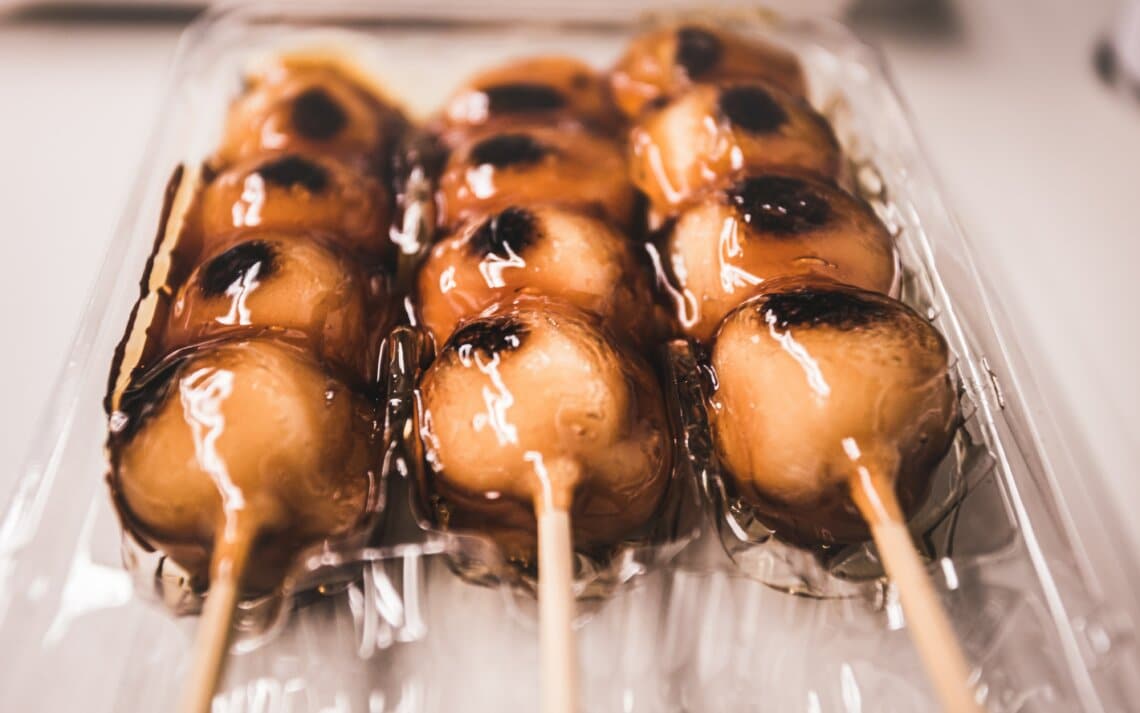
FAQ
Are Bento Boxes Eaten Cold?
While most bento and ekiben are designed to be delicious when eaten cold or at room temperature, on occasion, you may find bentos with self-heating boxes. Tucked inside the box is a heating element: simply pull the attached string and wait a few minutes for your meal to emerge steaming hot. Self-heating ekiben are usually more expensive, so if you’re keen to eat a hot meal, look out for the microwave ovens available at various shops and stations.
To assuage any fears about food safety and the lack of refrigeration on board, ekiben packaging will clearly feature both expiration dates and times.
What Is the Difference Between Ekiben and Bento?
There isn’t really a difference between ekiben and bento except in their names. Bento is the catch-all term for compactly packed lunch boxes, while ekiben are a specific type of bento for eating on a train – and in some ways is seen as the high-end gourmet version of bento. Similarly, soraben are the air travel alternatives, purchased at the airport and eaten while flying.
Are There Chopsticks in Ekiben?
Yes, ekiben typically come with disposable wooden chopsticks and a small oshibori. Depending on the specific dish, many will also include a packet of soy sauce, some pickled or fresh ginger, or other seasoning.
Can You Drink Alcohol on the Train?
Yes, it’s quite common for Japanese people to accompany their ekiben with a cold beer purchased from the train station. Some train stations also have small liquor stores where you can pick up local craft beers, jizake (local sake), or even small bottles of wine designed for train travel. Just don’t overdo it, as train travel in Japan is meant to be enjoyed quietly.
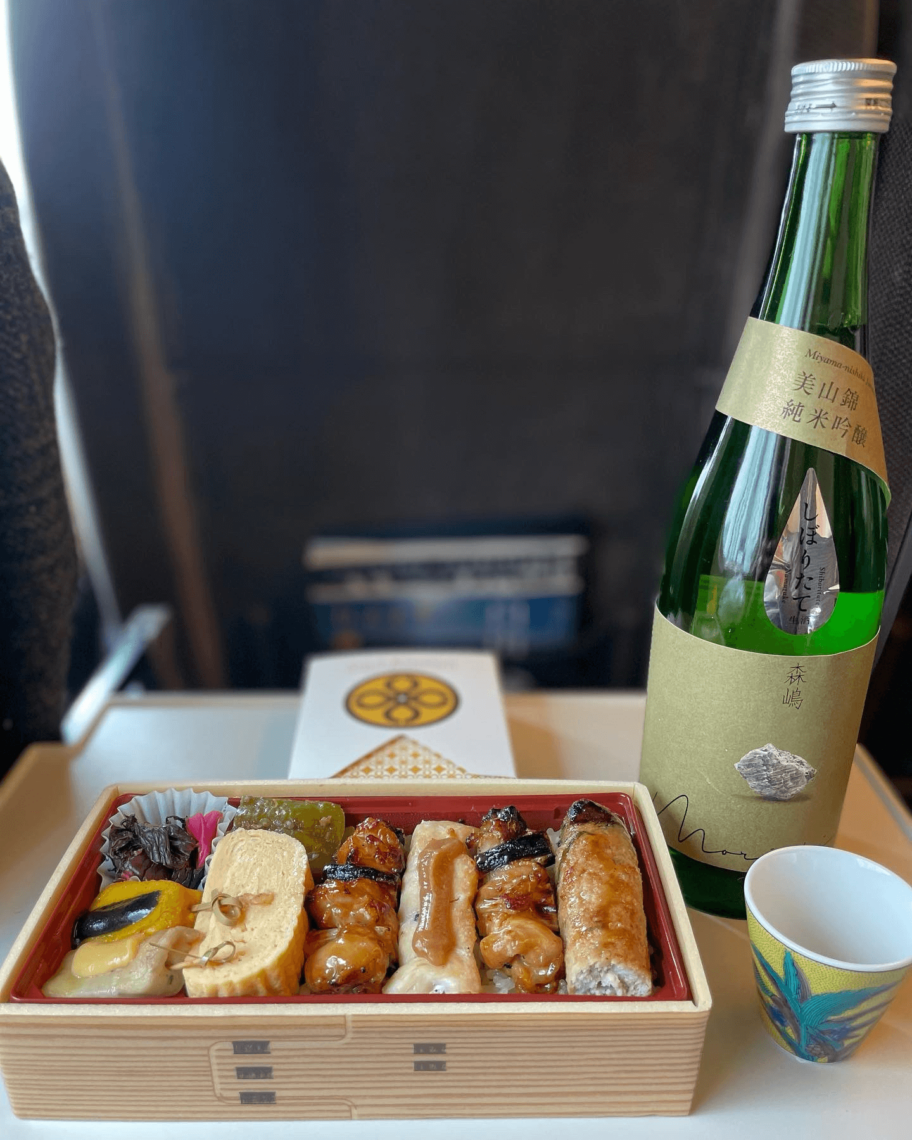
Which Ekiben Will You Try?
At Boutique Japan, we’re passionate about planning trips to suit your ideal mix of destinations, activities, and experiences – including food! Now that we’ve awoken your taste buds, get in touch about building a custom Japan itinerary that includes the country’s most unique and delicious food experiences.


